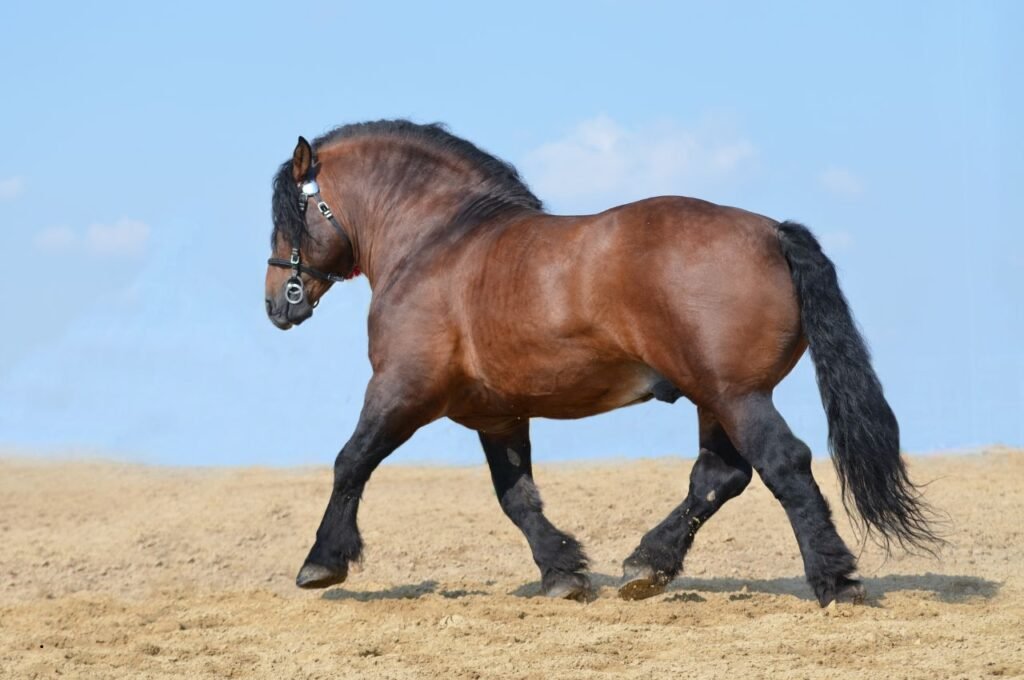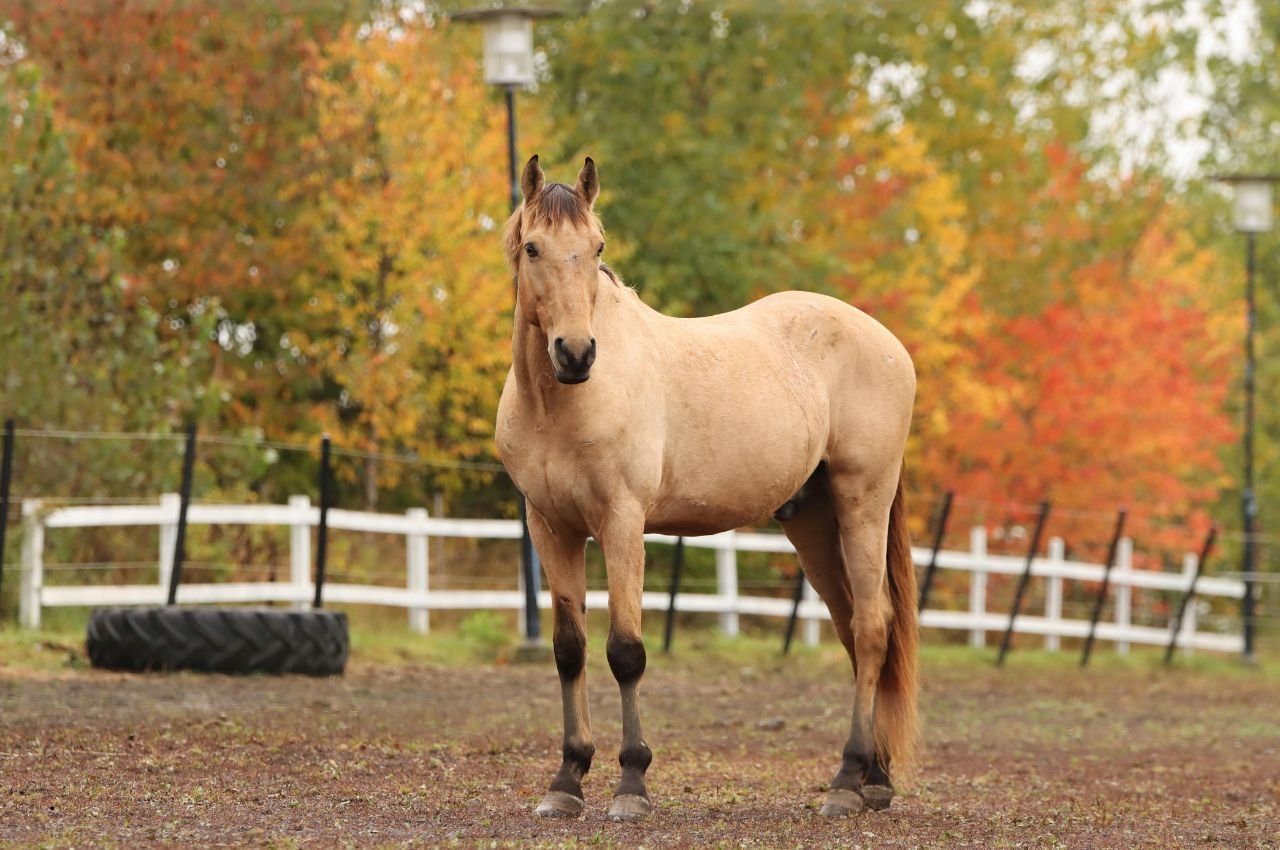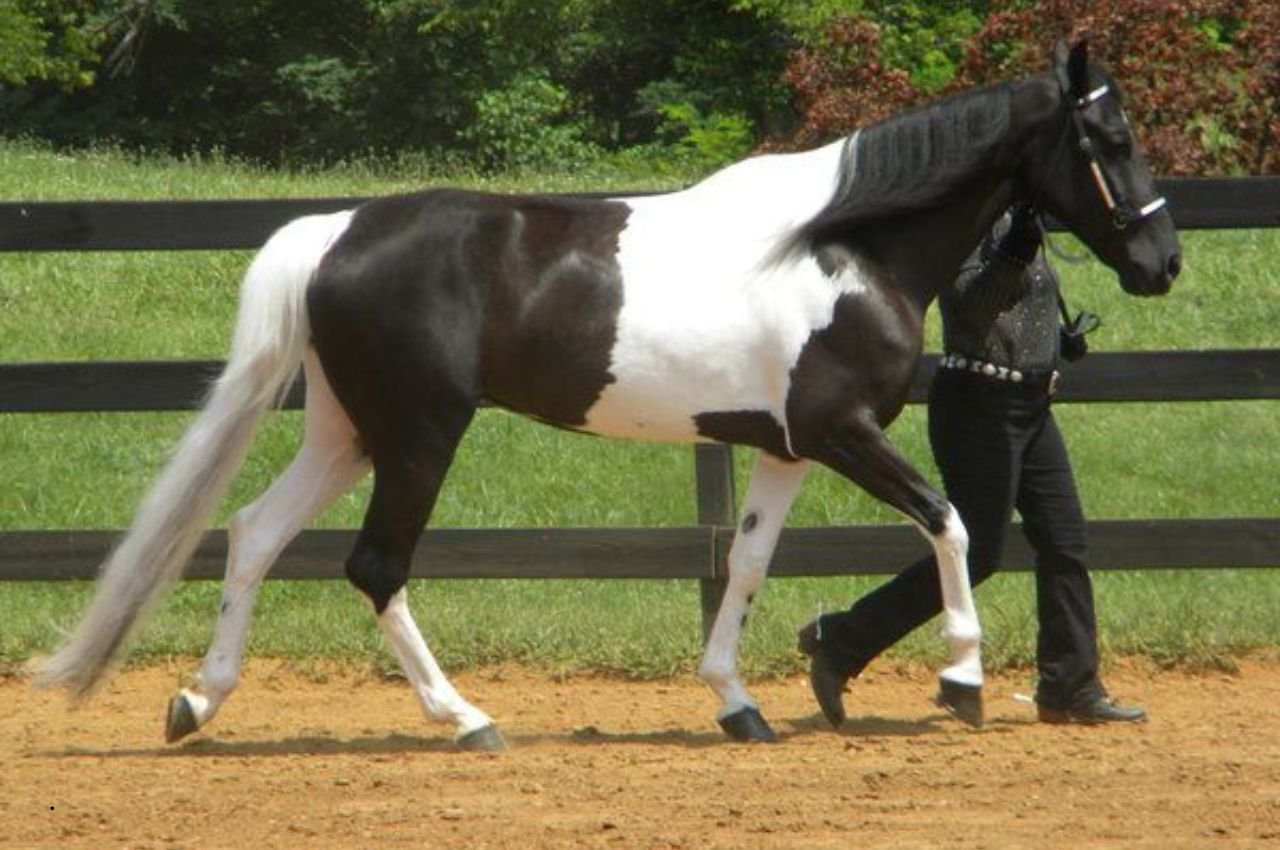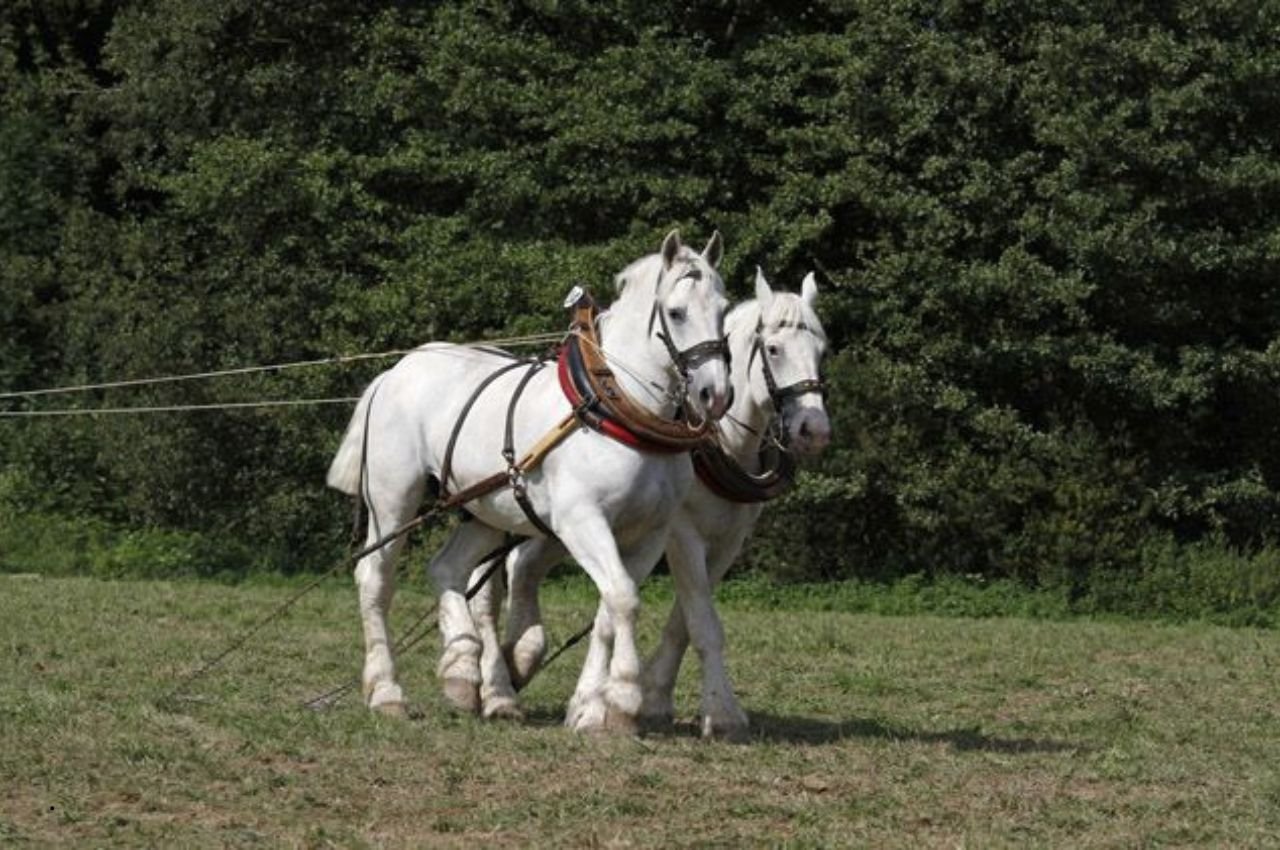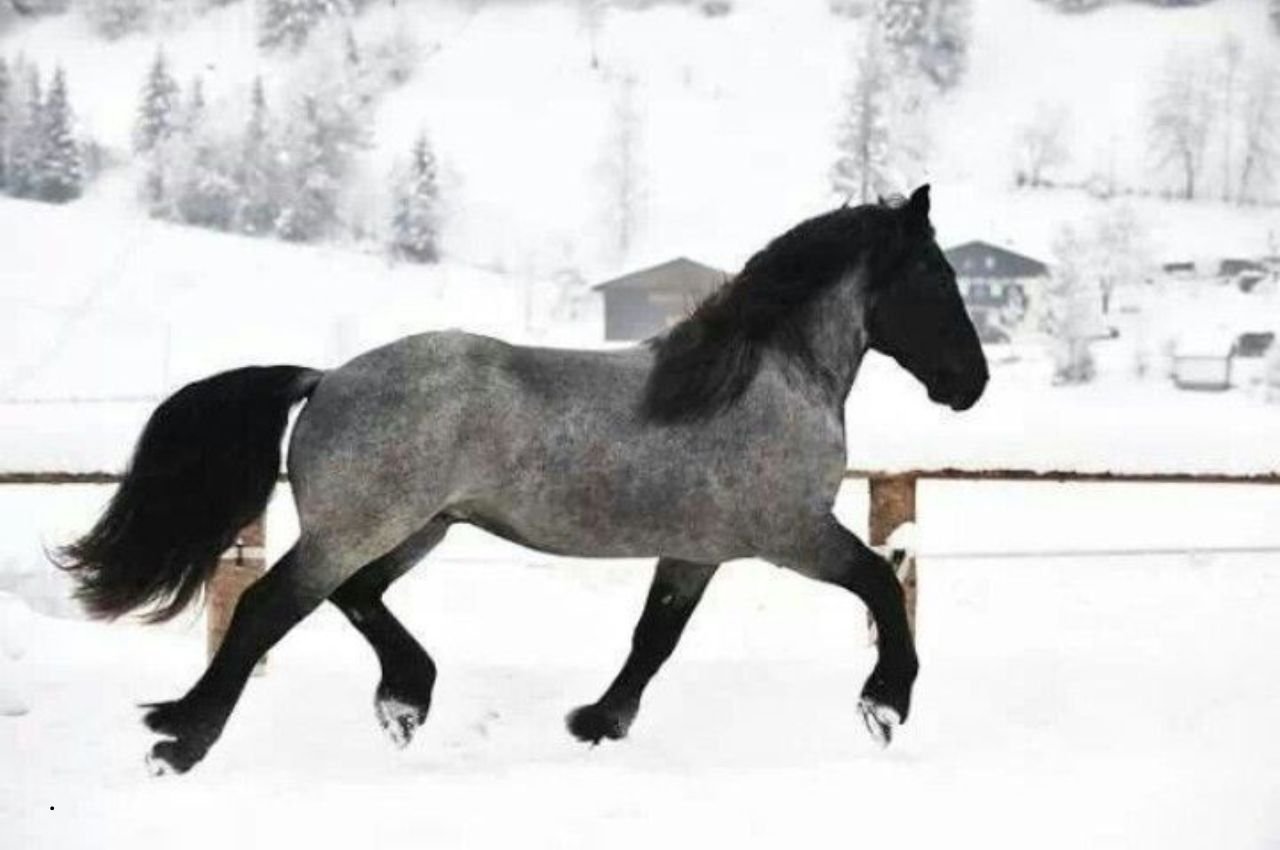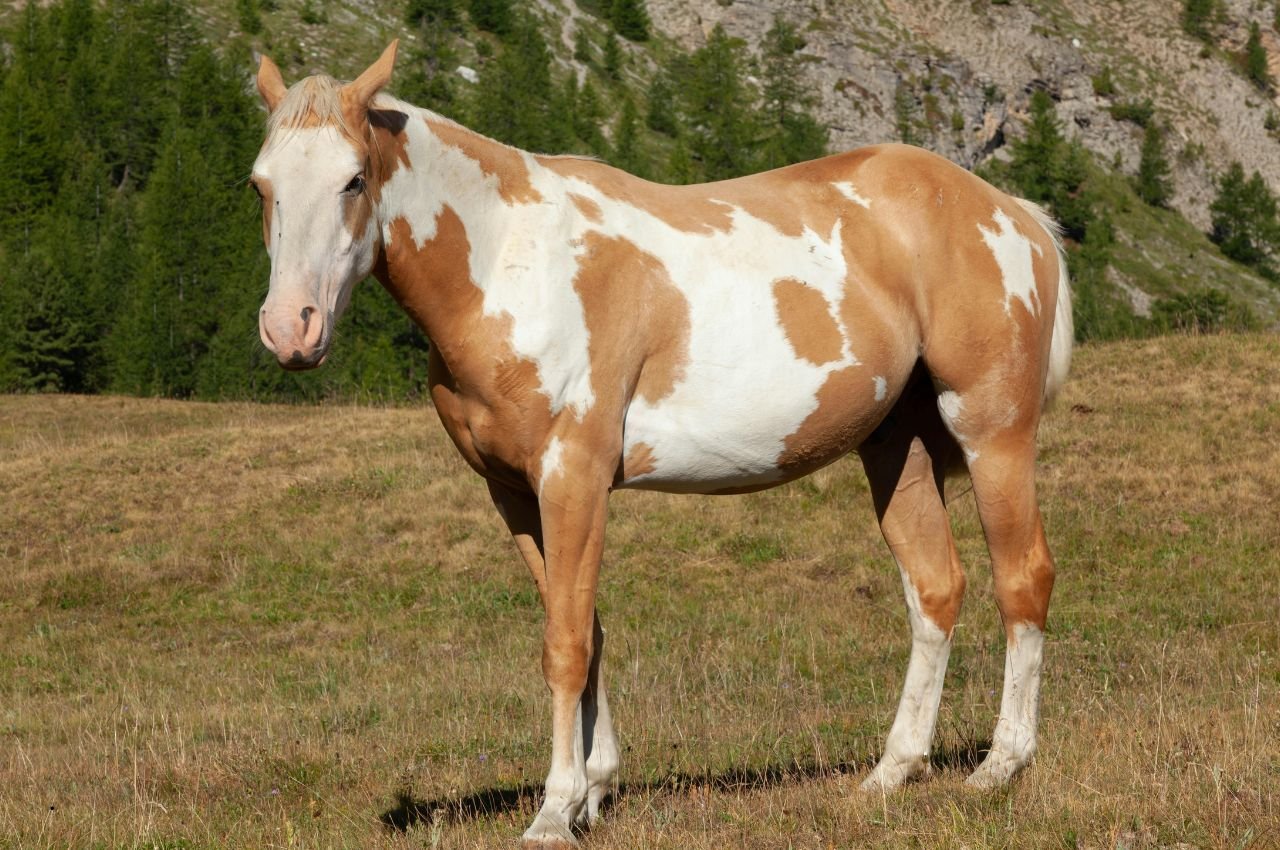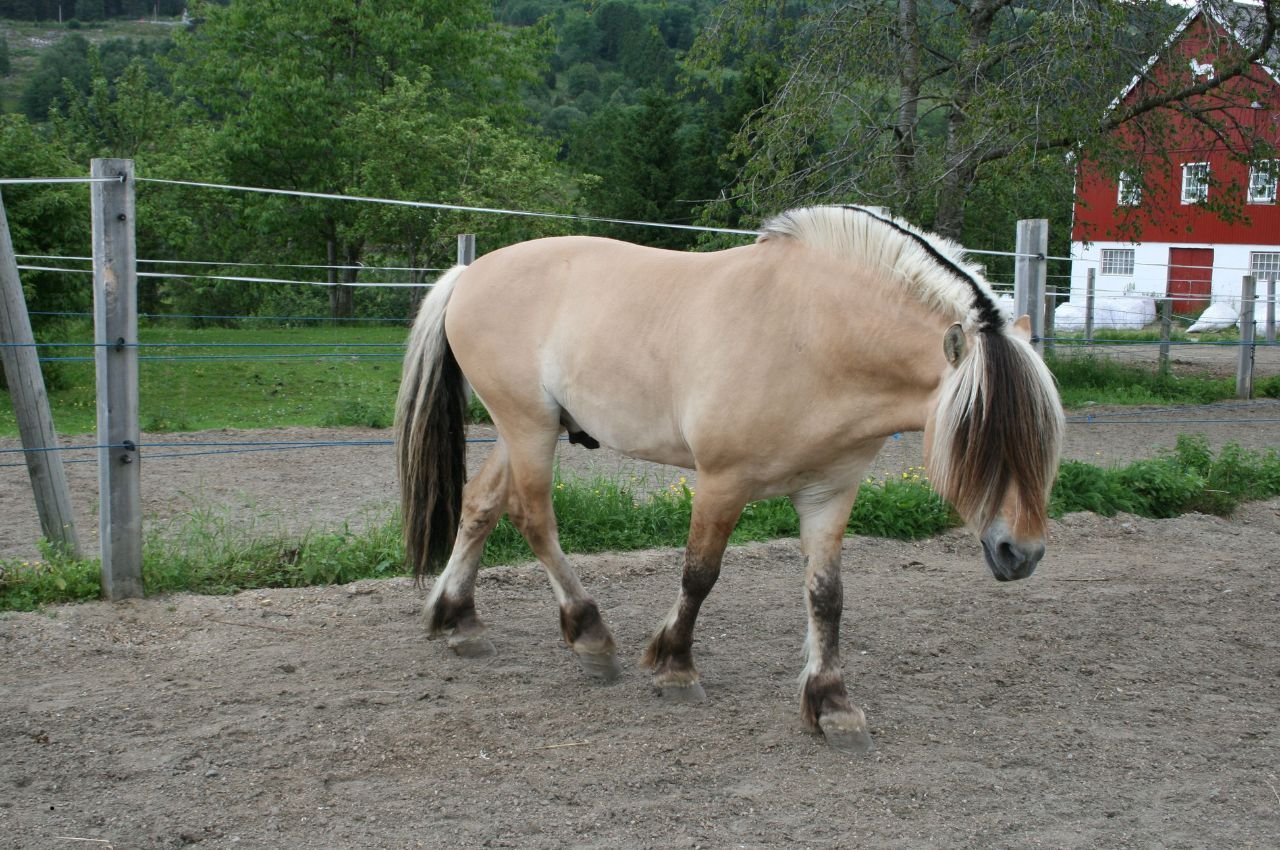The Soviet Heavy Draft Horse stands as a monument to systematic equine breeding excellence, representing one of the most successful heavy horse breeding programs of the 20th century. It derives from the Belgian Brabant heavy draft breed and was developed in the former Soviet Union for agricultural draft work, recognized as a breed in 1952. This remarkable breed embodies the perfect fusion of Belgian Brabant power with Russian durability, creating horses that excel in both agricultural applications and specialized production purposes.
The selective breeding that created the Soviet Heavy Draft resulted in a massively-built horse with free-moving gaits, establishing a breed that combines tremendous pulling power with surprising agility and endurance. What truly distinguishes this breed from other heavy draft horses is their remarkable dual-purpose nature – they excel not only as powerful working horses but also as exceptional producers of both milk and meat, making them uniquely valuable in agricultural systems where efficiency and versatility are paramount.
Historical Development and Origins
The fascinating story of the Soviet Heavy Draft Horse begins in the late 19th century Russian Empire, where agricultural modernization demands required the development of powerful, adaptable draft horses suited to the vast and varied landscapes of Russia. The Soviet Heavy Draft was developed in the 19th century Russian Empire as an agricultural draft work that developed alongside a few other draft breeds, including the Russian Draft.
Early Foundation and Development
The development of the Soviet Heavy Draft represents one of the most ambitious horse breeding projects in modern history. Russian agricultural reformers recognized that the empire’s vast agricultural potential could only be realized with horses specifically adapted to local conditions while possessing the power and endurance necessary for intensive farm work.
The foundation breeding program drew heavily from Belgian Brabant bloodlines, chosen for their exceptional pulling power and substantial build. However, Russian breeders didn’t simply import and multiply foreign horses – they embarked on a systematic program of selective breeding that would adapt these powerful horses to Russian conditions while enhancing their natural abilities.
Soviet Era Refinement
The establishment of the Soviet Union brought new focus and resources to agricultural improvement programs, including the systematic development of specialized horse breeds. The Soviet Heavy Draft program represented a cornerstone of these efforts, with state-sponsored breeding operations working to create horses that would serve multiple functions within the planned agricultural economy.
It is one of several heavy draft breeds developed in the Soviet Union in the twentieth century, others being the Russian Heavy Draft – which derived mainly from the Ardennais – and the Vladimir Heavy Draft, which was derived principally from the Clydesdale. This systematic approach to breed development created complementary breeds that could serve different specialized functions within Soviet agriculture.
The breed’s official recognition in 1952 marked the culmination of decades of careful breeding and selection. By this time, the Soviet Heavy Draft had proven its value not only as a powerful working horse but also as an efficient producer of milk and meat, making it uniquely valuable in the resource-conscious Soviet agricultural system.
Population and Distribution
In 1980 the total population was about 35,000, of which almost 4,000 were pure-bred. This substantial population represented the success of the breeding program and the widespread adoption of the breed throughout Soviet agricultural operations. The large population also ensured genetic diversity and the ability to continue selective breeding programs for ongoing improvement.
The distribution of Soviet Heavy Draft horses extended throughout the former Soviet Union, with breeding operations established to serve regional agricultural needs while maintaining breed standards and genetic quality. This widespread distribution demonstrated the breed’s adaptability to various climates and working conditions across the vast Soviet territory.
Physical Characteristics and Conformation
The Soviet Heavy Draft Horse presents an impressive and immediately recognizable appearance that reflects its breeding for maximum power and efficiency. It has a straight or convex profile, and a short neck. The torso is wide and muscular, creating the substantial build necessary for heavy draft work while maintaining the balance and coordination needed for efficient movement.
Size and Build Specifications
Soviet Heavy Draft horses represent the epitome of heavy draft horse development, with stallions typically weighing between 700-900 kg (1,540-1,980 pounds) and mares weighing 650-800 kg (1,430-1,760 pounds). This substantial mass is distributed across a frame that typically stands 15.2-16.2 hands high, creating a compact, powerful build optimized for maximum pulling efficiency.
The breed’s conformation reflects careful selection for functional excellence rather than merely impressive appearance. Every aspect of their build serves the practical purpose of creating maximum pulling power while maintaining the soundness necessary for long working careers.
Head and Neck Structure
The head of the Soviet Heavy Draft demonstrates the breed’s Belgian Brabant heritage while showing adaptations for Russian conditions. The straight or slightly convex profile indicates strength and character, while the intelligent eyes reflect the breed’s trainability and cooperative nature.
The short, thick neck provides the leverage necessary for maximum pulling efficiency while contributing to the overall impression of power and substance. This neck structure, combined with well-developed shoulder muscles, creates the ideal attachment points for draft harness while distributing pulling forces efficiently throughout the horse’s frame.
Body and Limb Conformation
The torso represents the most impressive aspect of Soviet Heavy Draft conformation, with exceptional width and muscular development that provides the power source for their legendary pulling ability. The deep, broad chest allows for maximum heart and lung capacity, supporting the sustained effort required for heavy draft work.
The back is characteristically short and strong, providing efficient power transmission from the hindquarters to the harness attachment points. This structural efficiency means that Soviet Heavy Draft horses can generate more pulling force per unit of body weight than many other draft breeds, making them exceptionally efficient workers.
The limbs show the substantial bone and muscular development necessary to support and propel such massive horses. The legs are well-proportioned to the body size, with strong, clean joints and well-developed hooves that provide secure footing under various working conditions.
Coat Colors and Markings
Soviet Heavy Draft horses typically display colors that reflect their Belgian origins, with chestnut being the most common color, often accompanied by flaxen manes and tails that create a striking and recognizable appearance. Bay, brown, and occasionally gray colors also occur within the breed, providing some variety while maintaining breed characteristics.
The coat quality itself reflects the breed’s adaptation to Russian climates, with a dense, weather-resistant coat that provides protection during harsh winters while remaining manageable during summer working seasons. This climate adaptation has been crucial to the breed’s success in the varied conditions found throughout the former Soviet Union.
Temperament and Behavioral Characteristics
The Soviet Heavy Draft Horse exhibits a temperament that perfectly complements their physical capabilities, combining the power necessary for heavy work with the docility and intelligence required for safe, efficient cooperation with human handlers. The animals are adapted to local conditions, possess significant muscular strength and a calm disposition.
Mental and Emotional Traits
The breed’s temperament reflects generations of selection for horses that could work effectively in agricultural settings while remaining safe and manageable for handlers of varying skill levels. Their calm, patient nature makes them particularly suitable for sustained work efforts where maintaining steady performance over long periods is more valuable than short bursts of intense activity.
Intelligence represents another key characteristic of the Soviet Heavy Draft, with horses demonstrating the ability to learn complex tasks and adapt to changing work requirements. This cognitive ability makes them particularly valuable for work that requires decision-making and adaptation to varying conditions, such as forestry operations or complex agricultural tasks.
Work Ethic and Cooperation
The breed’s legendary work ethic stems from generations of selection for horses that approached work with enthusiasm and persistence. Soviet Heavy Draft horses typically demonstrate what horsemen call “heart” – the willingness to give maximum effort even when the work becomes demanding or challenging.
Their cooperative nature makes them particularly suitable for teamwork, both with other horses and with human handlers. This cooperation is essential for the complex coordination required in agricultural operations where horses must respond to subtle cues while managing substantial loads or working in confined spaces.
Adaptability and Learning Ability
Soviet Heavy Draft horses demonstrate remarkable adaptability to varying work conditions and requirements. This flexibility allowed them to serve successfully in the diverse agricultural operations found throughout the Soviet Union, from grain farming in the steppes to forestry work in mountainous regions.
Their learning ability extends beyond simple task training to include the development of judgment and initiative that experienced working horses display. Mature Soviet Heavy Draft horses often anticipate work requirements and adapt their behavior to optimize efficiency and safety, demonstrating the intelligence that makes them valuable long-term partners rather than merely powerful machines.
Strength and Performance Capabilities
The Soviet Heavy Draft Horse’s reputation for exceptional strength and performance capability stems from both their substantial physical build and their efficient movement patterns. At present, the demand for this horse is still high mainly because of its massive size and free gaits.
Power Output and Pulling Capacity
Soviet Heavy Draft horses represent the pinnacle of pulling power among draft breeds, with exceptional ability to generate and sustain the forces necessary for heavy agricultural and industrial work. Their combination of substantial body weight, powerful muscular development, and efficient biomechanics allows them to pull loads that would challenge much larger horses.
The breed’s power output characteristics make them particularly valuable for work requiring sustained pulling efforts rather than just peak force generation. This endurance-oriented power delivery suits them ideally for agricultural applications where consistent performance throughout long working days is more important than short-term maximum output.
Movement and Gait Characteristics
Despite their massive build, Soviet Heavy Draft horses display surprisingly free and efficient movement patterns that contribute significantly to their working effectiveness. The selective breeding that created the Soviet Heavy Draft resulted in a massively-built horse with free-moving gaits, demonstrating that power and agility need not be mutually exclusive characteristics.
The breed’s movement efficiency translates directly into working effectiveness, allowing them to maintain productive output while minimizing energy expenditure and physical stress. This efficiency contributes to their legendary longevity and ability to remain productive workers throughout extended careers.
Endurance and Stamina
The endurance capabilities of Soviet Heavy Draft horses reflect both their physical conditioning and their mental approach to work. Their ability to maintain consistent output over extended periods makes them particularly valuable for sustained agricultural operations where reliability and persistence are essential.
This endurance extends beyond purely physical capabilities to include the mental stamina necessary for complex, demanding work. Soviet Heavy Draft horses typically maintain focus and cooperation throughout long working days, demonstrating the psychological durability that complements their physical capabilities.
Nutritional Requirements and Feeding Management
Proper nutrition forms the foundation for maintaining Soviet Heavy Draft horses in optimal condition for work and production. They have a good weight gain per fodder unit but demand good management, indicating that while they are efficient feed converters, they require knowledgeable management to reach their full potential.
Basic Energy and Forage Requirements
Like other breeds, mature draft horses should be fed a minimum of 1.5% of their body weight in forage daily, with a total intake between 1.5% and 3% of their body weight daily. For a typical Soviet Heavy Draft horse weighing 750 kg (1,650 pounds), this translates to a daily forage requirement of 11.25-22.5 kg (25-50 pounds) of high-quality hay or equivalent pasture intake.
The substantial size of Soviet Heavy Draft horses means their absolute feed requirements are considerable, but their efficient metabolism helps optimize the conversion of feed into productive work output. Maximal daily intake is estimated to be 2.5%–3% body weight in dry matter, providing guidelines for maximum feeding levels without risking digestive issues.
Energy Requirements for Working Horses
Working Soviet Heavy Draft horses require significantly more energy than horses at maintenance, with requirements varying based on work intensity and duration. Heavy work may increase energy needs by 50-100% above maintenance levels, requiring careful adjustment of both forage quality and concentrate feeds.
Good-quality grass hay or grass-legume mixes usually suffice for maintenance and light work, but intensive operations typically require additional energy-dense feeds to meet the increased demands of sustained heavy work.
Protein and Growth Considerations
The Soviet Heavy Draft mature extremely early and era good milk and meat producers. With normal feeding and management the foal at weaning attain a live weight of 360-400 kg. This rapid early growth requires careful protein management to support healthy development without creating orthopedic problems.
Young, growing Soviet Heavy Draft horses require protein levels of 14-18% in their total diet, while mature horses typically need 8-12% depending on their work level and reproductive status. High-quality protein sources like alfalfa hay or commercial protein supplements help ensure adequate amino acid profiles for optimal development and maintenance.
Mineral and Vitamin Supplementation
The substantial size and rapid growth rate of Soviet Heavy Draft horses create increased demands for minerals and vitamins compared to lighter breeds. Calcium and phosphorus requirements are particularly important for supporting proper bone development and maintenance in these heavy horses.
Trace mineral supplementation should address potential deficiencies in local feed sources while supporting the increased metabolic demands of working horses. Regular feed analysis helps identify specific supplementation needs based on local conditions and feed sources.
Feeding Management for Production Purposes
The breed’s record milk yield is 6320 kg, demonstrating their exceptional production capability when managed appropriately. Lactating mares require substantial increases in both energy and protein intake to support milk production while maintaining body condition and health.
The dual-purpose nature of Soviet Heavy Draft horses means feeding programs must balance work requirements with production goals. Lactating mares in work require particularly careful nutritional management to meet the combined demands of milk production and physical labor.
Health Management and Veterinary Care
Soviet Heavy Draft horses generally exhibit robust health and hardiness, but their substantial size and intensive use patterns create specific health management requirements. The animals are adapted to local conditions, possess significant muscular strength and a calm disposition, indicating natural hardiness that supports overall health maintenance.
Preventive Health Care Programs
Comprehensive preventive health care for Soviet Heavy Draft horses should address both standard equine health needs and the specific requirements of large, working horses. Regular veterinary examinations help identify potential problems before they impact performance or welfare.
Vaccination programs should be tailored to local disease risks and the horse’s exposure level, with particular attention to diseases that can affect large horses or horses used in agricultural settings. Core vaccines typically include protection against tetanus, encephalomyelitis, West Nile virus, and other regionally important diseases.
Parasite Management Strategies
Parasite control requires special consideration for heavy draft horses, as their size means larger parasite burdens can develop before clinical signs become apparent. Regular fecal examinations and strategic deworming programs help maintain intestinal health and prevent performance-limiting parasite loads.
The extensive use of Soviet Heavy Draft horses in agricultural settings may increase exposure to various parasitic organisms, making consistent monitoring and prevention programs particularly important for maintaining health and productivity.
Musculoskeletal Health Monitoring
The substantial size and working demands placed on Soviet Heavy Draft horses require careful monitoring of musculoskeletal health throughout their careers. Regular assessment of joint function, muscle condition, and overall soundness helps identify developing problems before they become serious.
Farrier care takes on particular importance for heavy horses, as proper hoof balance and shoe selection directly impact the distribution of substantial loads through the limb structure. Regular, skilled horseshoeing helps prevent many common lameness problems while supporting optimal performance.
Work-Related Health Considerations
Working Soviet Heavy Draft horses face health challenges related to their intensive use patterns and substantial physical demands. Exercise conditioning programs should gradually prepare horses for work demands while monitoring for signs of overexertion or developing problems.
Heat management becomes particularly important for large horses engaged in sustained work, as their substantial mass and muscle activity generate significant body heat. Providing adequate cooling opportunities and monitoring for heat stress help maintain health and performance during demanding work periods.
Reproductive Health Management
The dual-purpose nature of Soviet Heavy Draft horses means many mares continue working during pregnancy and lactation, requiring specialized reproductive health management. Regular monitoring of pregnant mares helps ensure successful foaling while maintaining work capacity within safe limits.
Breeding soundness examinations for stallions should address both reproductive function and the overall health status necessary to maintain breeding activities alongside potential work responsibilities.
Management and Housing Requirements
Successful management of Soviet Heavy Draft horses requires understanding their specific needs as large, working animals while providing appropriate facilities and care routines. Their substantial size and intensive use patterns create unique management challenges that must be addressed for optimal health and performance.
Housing and Shelter Needs
Barn design for Soviet Heavy Draft horses must accommodate their substantial size while providing the comfort and protection necessary for working horses. Stall dimensions should be at least 14′ x 14′ (4.3m x 4.3m) to allow comfortable movement and lying down, with 16′ x 16′ stalls being preferable for larger individuals.
Ceiling height becomes particularly important for draft horses, with minimum heights of 10-12 feet needed to prevent injury from head contact. Door widths and heights must also be increased to accommodate the broader build and taller stance of these substantial horses.
The choice between individual stalls and group housing depends on management goals and facility design, but the generally calm temperament of Soviet Heavy Draft horses makes them suitable candidates for various housing systems when properly managed.
Pasture Management and Fencing
Pasture requirements for Soviet Heavy Draft horses reflect their substantial size and feed consumption, typically requiring 2-3 acres per horse for adequate forage production in good quality pastures. Poor quality pastures may require additional acreage to meet nutritional needs.
Fencing systems must be designed to contain horses weighing 700-900 kg safely and effectively. Board fencing, post and rail systems, and properly installed high-tensile wire all work well when constructed to appropriate specifications for heavy horses.
Pasture rotation becomes particularly important for heavy horses, as their size and weight can cause more rapid pasture degradation than lighter horses. Proper rotation helps maintain pasture quality while preventing overuse of preferred grazing areas.
Water and Feed Delivery Systems
The substantial daily water requirements of Soviet Heavy Draft horses – typically 35-50 gallons per day – require reliable water systems capable of meeting peak demand periods. Automatic waterers designed for large horses help ensure consistent water availability while reducing labor requirements.
Feed delivery systems should accommodate the large quantities of feed required by these substantial horses while preventing waste and maintaining feed quality. Hay feeders designed for draft horses help reduce waste while allowing natural feeding behaviors.
Climate and Seasonal Considerations
The Russian origins of Soviet Heavy Draft horses provide them with excellent cold weather tolerance, but proper management during extreme weather conditions remains important for maintaining health and productivity. Blanket systems may be beneficial for working horses or those maintained in intensive management systems.
Heat management becomes more challenging for large horses, requiring adequate shade, ventilation, and cooling opportunities during hot weather. The substantial heat production of working heavy horses requires particular attention to preventing heat stress during demanding work periods.
Training and Work Applications
The intelligence and cooperative nature of Soviet Heavy Draft horses make them excellent candidates for various training programs, while their substantial strength and endurance create opportunities for diverse work applications. Horses can be bred for harness work in agriculture, meat and dairy production.
Foundation Training Principles
Ground training forms the essential foundation for all Soviet Heavy Draft training programs. Their substantial size means that establishing clear communication and respect from the beginning is crucial for safety and effectiveness throughout their training and working careers.
Basic handling skills including leading, tying, grooming, and hoof care must be thoroughly established before advancing to more complex training. The cooperative nature of the breed generally makes this foundation training straightforward, but consistency and patience remain essential for developing reliable responses.
Draft Work Training
Traditional draft training remains highly relevant for Soviet Heavy Draft horses, whether intended for agricultural work, forestry operations, or commercial applications. The systematic progression from ground driving to full harness work allows horses to develop both the physical conditioning and mental understanding necessary for effective draft work.
Harness training should progress gradually, with particular attention to proper harness fitting for the horse’s substantial build. The power of Soviet Heavy Draft horses means that equipment selection and maintenance are crucial for both safety and performance.
Agricultural and Forestry Applications
Modern agricultural applications for Soviet Heavy Draft horses include sustainable farming operations, organic production systems, and specialized tasks where horse power provides advantages over mechanical alternatives. Their strength and reliability make them valuable for heavy cultivation, logging operations, and land management tasks.
Forestry training requires specialized skills for working in challenging terrain and around valuable timber. The sure-footedness and careful movement of well-trained Soviet Heavy Draft horses make them ideal for selective logging operations where precision is essential.
Commercial and Recreational Training
The impressive appearance and gentle temperament of Soviet Heavy Draft horses make them attractive candidates for commercial driving operations, including carriage services and tourism applications.
Recreational driving training emphasizes safety, comfort, and enjoyment for both horse and driver. The calm temperament and steady movement of Soviet Heavy Draft horses make them excellent choices for family driving and therapeutic driving programs.
Modern Applications and Uses
Contemporary uses for Soviet Heavy Draft horses span traditional agricultural applications, specialized production purposes, and emerging recreational and conservation roles. At present, the demand for this horse is still high mainly because of its massive size and free gaits.
Agricultural and Production Uses
The Soviet Heavy Draft mature extremely early and era good milk and meat producers. This dual-purpose capability makes them valuable in agricultural systems where horses serve multiple functions beyond simple draft work.
Modern sustainable farming operations increasingly recognize the benefits of horse-powered agriculture, particularly in organic farming systems where chemical inputs are minimized and environmental impact is a concern. The power and reliability of Soviet Heavy Draft horses make them ideal for these applications.
Market garden operations benefit from the precision and environmental sensitivity that horse power provides, while the horses’ production capabilities add additional value to the farming system through milk and meat production.
Forestry and Land Management
Selective logging operations represent an important modern application where Soviet Heavy Draft horses provide significant advantages over mechanical alternatives. Their ability to work in sensitive environments without causing soil compaction or damage to remaining vegetation makes them valuable for sustainable forestry practices.
Land restoration projects often benefit from horse power, where heavy machinery would cause additional environmental damage. The controlled power application and precise maneuvering ability of trained horses make them ideal for these sensitive applications.
Recreational and Educational Uses
Agritourism operations increasingly incorporate Soviet Heavy Draft horses to provide authentic experiences about traditional farming methods and human-horse partnerships. Educational programs help preserve knowledge about working horses while engaging urban populations with agricultural heritage.
Draft horse competitions provide venues for showcasing breed qualities while maintaining breeding standards and performance capabilities. These events help preserve traditional skills while promoting continued interest in working horses.
Conservation and Genetic Preservation
The historical significance of Soviet Heavy Draft horses makes them important subjects for genetic conservation efforts. Breed registries and conservation organizations work to maintain genetic diversity while preserving the characteristics that made the breed successful.
International breeding programs help ensure breed survival while adapting to different management systems and climatic conditions outside their original range.
Frequently Asked Questions (FAQs)
General Breed Information
Q: How large do Soviet Heavy Draft horses typically get? A: Soviet Heavy Draft horses are among the largest draft breeds, with stallions typically weighing 700-900 kg (1,540-1,980 pounds) and mares weighing 650-800 kg (1,430-1,760 pounds). They typically stand 15.2-16.2 hands high, creating a compact but massively powerful build.
Q: What makes Soviet Heavy Draft horses different from other draft breeds? A: The Soviet Heavy Draft mature extremely early and era good milk and meat producers, making them unique among draft breeds for their dual-purpose capabilities. Their combination of Belgian Brabant strength with Russian hardiness creates horses with exceptional working ability and production potential.
Q: Are Soviet Heavy Draft horses rare today? A: While not as common as during their peak in the Soviet era, in 1980 the total population was about 35,000, of which almost 4,000 were pure-bred. Current populations are smaller but stable, with conservation efforts working to maintain breed integrity.
Q: What colors do Soviet Heavy Draft horses come in? A: The most common color is chestnut with flaxen mane and tail, reflecting their Belgian heritage. Bay, brown, and occasionally gray also occur within the breed standards.
Care and Management
Q: How much space do Soviet Heavy Draft horses need? A: Due to their substantial size, Soviet Heavy Draft horses typically require 2-3 acres of quality pasture per horse for adequate forage. Stalls should be at least 14′ x 14′ with larger dimensions being preferable for comfort and safety.
Q: What special equipment is needed for Soviet Heavy Draft horses? A: Their massive size requires draft-sized equipment including extra-large halters, bridles, blankets, and harness. Barn facilities need higher ceilings and wider doors to accommodate their substantial build.
Q: How long do Soviet Heavy Draft horses typically live? A: With proper care, Soviet Heavy Draft horses typically live 20-25 years. Their robust constitution and genetic hardiness contribute to good longevity when maintained properly.
Q: Can Soviet Heavy Draft horses live outdoors year-round? A: Their Russian heritage provides excellent cold weather tolerance, making them well-suited to outdoor living with appropriate shelter. However, working horses benefit from barn access during extreme weather.
Feeding and Nutrition
Q: How much do Soviet Heavy Draft horses eat per day? A: Like other breeds, mature draft horses should be fed a minimum of 1.5% of their body weight in forage daily, with a total intake between 1.5% and 3% of their body weight daily. For a 750 kg horse, this means 11-22 kg (25-50 pounds) of feed daily.
Q: Are Soviet Heavy Draft horses efficient feed converters? A: They have a good weight gain per fodder unit but demand good management. While they are efficient converters, their substantial size means absolute feed requirements remain high, requiring careful nutritional management.

